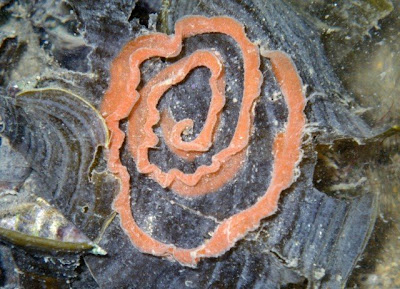One never gets bored exploring Singapore's intertidal shores because there are still many shores awaiting for us to explore. Today, a small team of four decided to visit a new stretch of Tanah Merah, which Ron, Luan Keng and Samson has visited too previously. It's a trip that I have been anticipating for quite a while before finally setting a date to check this shore out.
The intertidal area is filled with countless number of Creeper snails (Family Cerithiidae) and the delightful Dubious nerite snail (Clithon oualaniensis)!
On the sandy part of the shore, there are many processed casts of the Acorn Worm (Class Enteropneusta). Acorn worms swallow mud and sand and process these for edible bits. At low tide, they stick out their rear ends at the surface and excrete coils of processed sediments which is the processed cast.
Today we had quite good fishy finds!
The top fishy find of the day will be this really cute Longhorn cowfish (Lactoria cornuta) that Mei Lin spotted! Wow!!! I've never seen a cowfish before and would least expect to find it at Tanah Merah.
And of course, we are too excited to see that cowfish that it took us quite some time before we realized there was a Fan-bellied filefish (Monacanthus chinensis) just beside the cowfish. They look quite buddy buddy huh... :-)
The cowfish has a pair of horns on the head with a downward pointing tubular mouth. It feeds on tiny animals hidden in the sand. The fish uncovers these titbits by blowing away the sand with its downturned tubular mouth. How cute!
Elsewhere, I also stumbled upon two more filefishes. Quite interesting to note that filefishes are found here since seaweed or seagrass is sparse or almost non existent.
I also chanced upon this Flathead (Family Platycephalidae) which is pretty in black and white. One doesn't need to be colourful to be appreciated.
It is called a flat head because of its broad and flatten head. Flatheads eat small fishes, octopus and cuttlefish, crustaceans and other animals that live on the bottom.
There are also several gobies swimming around the tidal pools.
This Blue-spined swimming crab (Thalamita sp.) is yet another delightful find and is more colourful than some other swimming crabs.
Ria later brought me to a patch of Common sea stars (Archaster typicus). Wow, I am glad that these sea stars can still be found on a mainland shore. They used to be in most shores of Singapore in the past, such as Changi and Punggol but now almost wiped out on any mainland shores due to habitat loss and overcollection. Glad there is still a population existing at Tanah Merah. It's even more heartening to see most of them are actually mating!
On the more rockier side of this shore, there are many shells of snails. Some are dead but if you look closely, there is a hermit crab inhabiting the shell! That's why we do not pick sea shells back home because we will be depriving hermit crabs of their homes.
Of course there are also live snails! James showed me his find of the Black-lipped conch (Strombus urceus). Like the common sea stars, the black-lipped conch used to be abundant in the past by now uncommon. It is listed as 'Vulnerable' on the Red List of threatened animals of Singapore.
We all realized that this shore is good shore to find lots of snails or gastropods! And there were a few interesting finds as listed below.
According to "A Guide to the Common Seashells of Singapore" by Tan, K. S. and L. M. Chou, this snail is probably Chicoreus torrefactus (Family Muricidae) which can found in sandy areas near reefs and feed on clams. It has an operculum or a hard 'trapdoor' attached to the foot.
This snail which looks like a small rock from the top looks pretty from the underside. If you notice the shell, it has a spiral of blunt spikes. In addition, it has a jade-green operculum. This snail is the Spurred turban snail (Astraea calcar).
This other snail that also looks like a rock is probably Angaria delphinus (Family Trochidae). Ron also saw this snail on his previous visit to this shore.
On the rocky area, one can also find the Spotted top shell snail (Trochus maculatus). It has a thick conical shell. Though from the top it looks quite well camouflaged to the surrounding with its encrusting lifeforms, the underside shows pretty patterns. For this snail, its operculum is thin and slightly yellowish in colour.
Ria and James found a couple of this pretty pink moon snail. It has a very pretty pink body with white lines. The operculum is chalky, white with a texture of concentric ridges.
I chanced upon this clam that I see for my first time. When I checked out "A Guide to the Common Seashells of Singapore" by Tan, K. S. and L. M. Chou, I realized that this clam is probably Barbatia fusca which live singly in the intertidal area attached to the underside of stones and rocks with their byssus threads.
As for worms, there were a number of the pretty banded fan worm. They are usually shy and rapidly retracts into its leathery tube at the slightest sign of danger.
Interestingly, I saw this egg coil at one of the seaweed's surface. Could this belong to a nudibranch? If yes, that will be exciting!
In overall, this sandy and rocky shore is a great place to spot gastropods though once in a while there are also some fishy surprises!
I later went on to explore the reefs beyond the sandy and rocky parts of the shore. More about the amazing corals found at Tanah Merah in a short while.
Tuesday, May 12, 2009
Exploring Tanah Merah
Subscribe to:
Post Comments (Atom)




















No comments:
Post a Comment